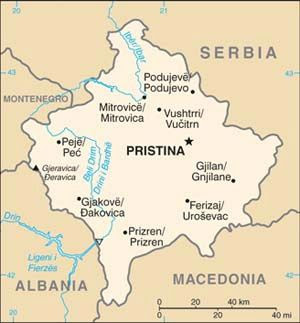Kosovo: Northern Strategies – Analysis
Only the US has the leverage to make the Kosovo Albanians come to the table in order to secure a compromise – one that keeps the north as part of Kosovo, yet not under Pristina – but this will have to be imposed on the Kosovo government.
By Gerard M. Gallucci
It has been a tumultuous year since Pristina sought to seize control of the northern Kosovo boundary last July. Barricades have come up and down, Pristina’s special police have tried further incursions, KFOR and EULEX have sought to corral the local Serbs. Shots were fired, bombs exploded and people died and were injured. More recently, Pristina and its Quint supporters have harassed Serbs over license plates and sought to establish its own “protected” direct rule over a sliver of north Mitrovica. Not a sterling record for the international “peacekeepers.”

Through it all, however, nothing essential has changed. The barricades are mostly down and the two northern “official” Gates are open. Travellers are passing through but with nary a sign of Pristina customs or police. Alternative roads are mostly unblocked. The northern Kosovo Serbs still refuse to accept any role of Pristina in their communities. Any possible compromise solution remains well out of reach given the use of force. If one wanted to keep score, one might say the northerners are “winning” simply by not having been forced to submit.
One might expect – hope, really – that the continued stalemate – despite KFOR and EULEX repeatedly exceeding their UN mandates in order to bully the Serbs – might have opened the way for trying dialogue. But conditions do not yet appear ripe. The northern Kosovo Serbs probably haven’t given much thought to what compromises they might be willing to accept in order to maintain their local self-government and links to Serbia proper. But they have been under considerable pressure and have no reason to trust either the internationals – UNMIK excepted – or Pristina.
The real problem may be that on the Quint/Pristina side there are differing agendas and strategies. Let me try to unpack these.
There may well be some who look to eventual negotiations to offer a way to “settle” the question of the north peacefully. They have finally taken on board the fact that an imposed solution is out of reach. So, the strategy is to soften up the Serbs on the ground while placing as many Pristina pieces on the northern board as possible before any opening to the northerners. KFOR takes down local Serbian defenses (the barricades), EULEX threatens to seize their Serbian license plates, Pristina establishes its own Potemkin administration in north Mitrovica while pushing new construction of Albanian housing there, continues to squeeze Trepca North and now reportedly will offer its own nine-point plan. Perhaps this plan will actually offer something new? It’s not necessarily rocket science to see how a compromise might be structured. Could be the US is taking this approach. After all, it’s been its NATO troops – plus the Germans – who have had to do most of the unpleasant work of corralling the northern Serbs. Who wants that job, really?
But others may not care much about negotiations. They push the same list of actions but for a different reason. They simply want to provide cover for their planned departure this year. Establish that new “municipality” in north Mitrovica, clear up the barricades, hide some Kosovo customs officers at the Gates and declare “mission accomplished.” They are ready to let the Ahtisaari Plan lapse – whatever the effect on Kosovo Serbs in the south – and end “supervised independence.” At least some of the Europeans – and perhaps Brussels itself – may belong in this camp. Their strategy being to pretend and split.
The Kosovo Albanian leadership prefers anything else to negotiations. Their agenda is still not to negotiate the north but to get it under their control. Their strategy has long-term and short-term elements. For now, they are quite content to ride the Quint wave of increased pressure on the Serbs. They also know how to send their own messages directly that they really don’t mean to talk – arrests, bombings, stoning and seizing plates not even in use. If this all somehow leads to violence or refusal by the northerners to talk, the Albanian side can take the initiative or simply out wait their internationals. This would play into their long-term approach of steadily – even if slowly – encroaching on the north and eventually forcing the Serbs to submit or leave.
So, it remains difficult to see how serious negotiations could even get underway. The key remains with Washington. Only the US has the leverage to make the Kosovo Albanians come to the table and stay there. If the US is open to a compromise that keeps the north as part of Kosovo but not under Pristina, then there remains a chance of working out a compromise. But it will have to be imposed on Pristina. Otherwise, more of the same, with the possibility of worse.
Gerard M. Gallucci is a retired US diplomat and UN peacekeeper. He worked as part of US efforts to resolve the conflicts in Angola, South Africa and Sudan and as Director for Inter-American Affairs at the National Security Council. He served as UN Regional Representative in Mitrovica, Kosovo from July 2005 until October 2008 and as Chief of Staff for the UN mission in East Timor from November 2008 until June 2010. Gerard is also a member of TransConflict’s Advisory Board.
